Introduction
In a world where aging gracefully is a priority, the significance of core strength for seniors cannot be overstated. As individuals age, maintaining stability, balance, and mobility becomes increasingly essential to foster independence and enhance quality of life. Core strength serves as the foundation for these vital attributes, supporting the spine and promoting proper posture while significantly reducing the risk of falls.
With targeted core exercises, older adults can combat the natural decline in muscle mass and strength, paving the way for a more active lifestyle. By prioritizing core health, HR Benefits Managers have the opportunity to empower seniors, ensuring they navigate daily activities with confidence and ease.
The journey toward improved well-being begins with understanding the importance of core strength and the transformative impact it can have on the lives of older adults.
The Importance of Core Strength for Seniors
Core exercises for seniors are essential, as they play a fundamental role in stability, balance, and overall mobility. A strong foundation supports the spine and promotes proper posture, significantly reducing the risk of falls and related injuries. With the natural decrease in muscle mass and strength that happens with aging, participating in core exercises for seniors becomes more crucial.
Research indicates that core exercises for seniors lead to significant improvements in balance, particularly in populations recovering from surgery, as noted by Ketki Vishvanath Ponde from the Smt. Kashibai Navale College of Physiotherapy, who stated,
Core stabilization exercises had significant improvement on balance variables in the experimental group when compared to the control group.
Furthermore, a review of randomized controlled trials (RCTs) demonstrates that strength training can enhance muscle strength in older adults, yielding improvements in mobility and functional tasks. For example, low-intensity training set at 10% of 1RM with 10 sets of 15 repetitions has been shown to be effective in this regard. Furthermore, findings indicate that core exercises seniors can improve recovery of walking ability and balance function in postoperative patients, demonstrating the wider implications of strength beyond just fall prevention.
While the effects on function may be modest, the benefits of increased strength, improved quality of life, and enhanced independence are undeniable.
Statistics from recent studies show a diverse participant pool, including:
- A total of 172 participants in balance studies
- 280 in throwing/hitting studies
- 483 in jump studies
This highlights the broad applicability of these findings. By prioritizing essential strength programs, HR Benefits Managers can empower seniors to lead more active lifestyles through core exercises seniors and enjoy greater autonomy. It’s time to incorporate core exercises seniors into health and wellness strategies for older adults, ensuring they can navigate their daily activities with confidence and ease.
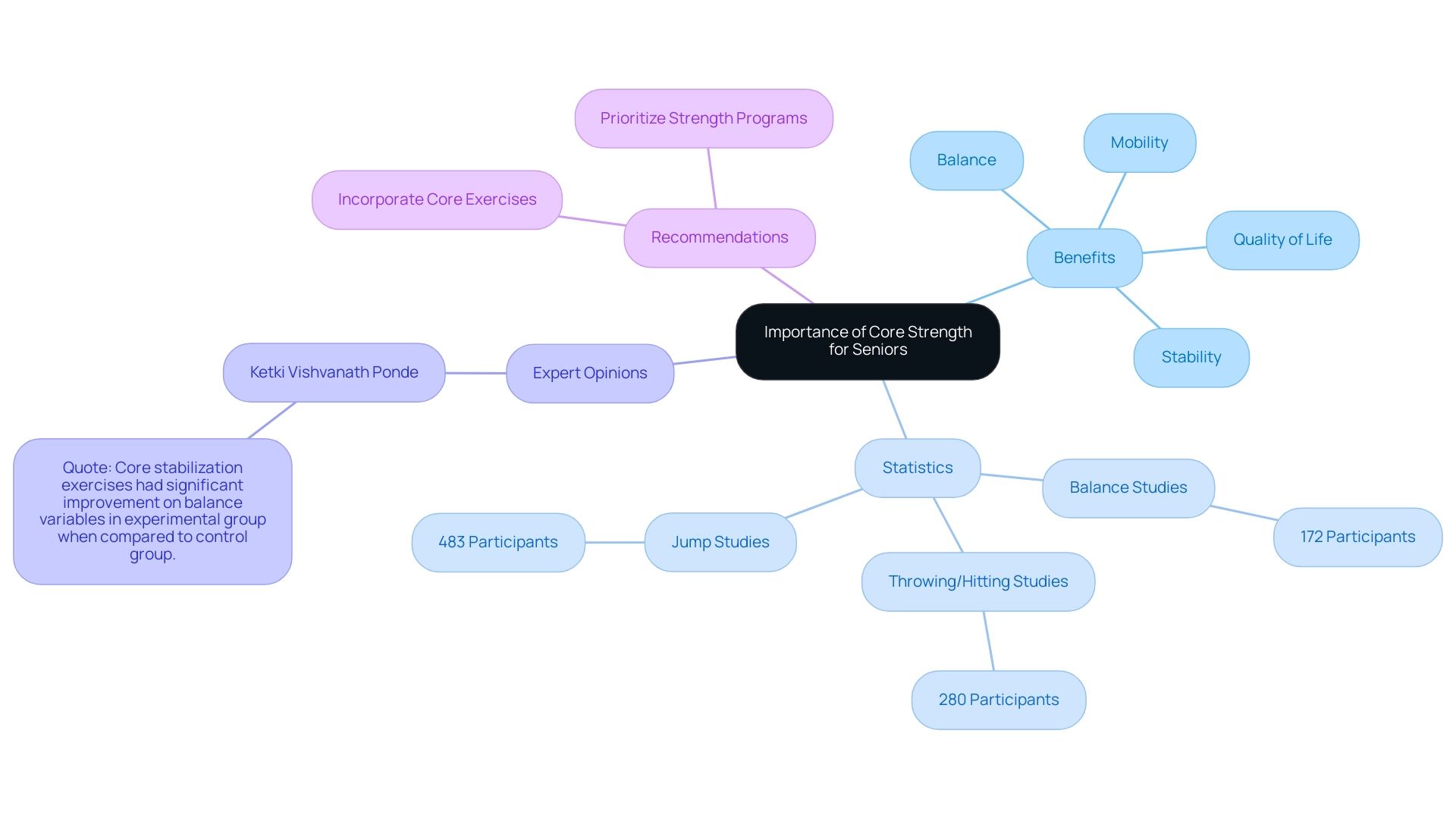
Effective Core Exercises Tailored for Seniors
- Seated Marching: Begin by sitting on a sturdy chair with your back straight and feet flat on the ground. Lift one knee toward your chest, lower it back down, and repeat with the opposite leg. This simple yet effective movement, which includes core exercises seniors can perform, not only strengthens the lower abdominal muscles but also enhances balance, crucial for maintaining independence as we age. Research has indicated that efficient fundamental workouts can provoke substantial muscle activity, as illustrated by the clean and jerk with a 20 kg water bag, which exhibited EMG activity of 60.00 ± 7.90 % MVIC.
- Standing Side Leg Lifts: Stand behind a chair for stability. Keeping your leg straight, lift one leg out to the side and then lower it back down. This activity is excellent for enhancing the hip and abdominal muscles, which aids in boosting mobility and avoiding falls. As noted by fitness experts, incorporating core exercises for seniors is essential for senior fitness programs.
- Chair Yoga: Embrace the calming benefits of gentle yoga while seated. Include poses such as seated twists and forward bends to activate the abdomen and enhance flexibility. These core exercises for seniors can significantly enhance both physical and mental well-being, providing a holistic approach to fitness. J.M.M. emphasizes that engaging in these types of exercises can lead to improved health outcomes for older adults.
- Wall Sit: Position yourself with your back against a wall and slide down until your knees reach a 90-degree angle. Hold this position for as long as you can. Wall sits are beneficial as core exercises for seniors, helping to strengthen the abdominal area, legs, and back while promoting overall stability and endurance. This aligns with findings from Calatayud et al. (2014), which highlighted the effectiveness of various push-up variations in enhancing central strength.
- Pelvic Tilts: Lie on your back with knees bent and feet flat on the floor. Tighten your abdominal muscles and gently flatten your back against the floor. Hold for a few seconds before releasing. This activity not only fortifies the lower back but also involves the abdominal muscles, making it a vital part of core exercises seniors should incorporate into any strength-building regimen.
These activities reflect the latest trends in senior fitness, emphasizing seated and low-impact movements, which are considered core exercises for seniors that support stability and overall well-being. Incorporating them into regular routines can lead to significant improvements in health and quality of life for older adults.
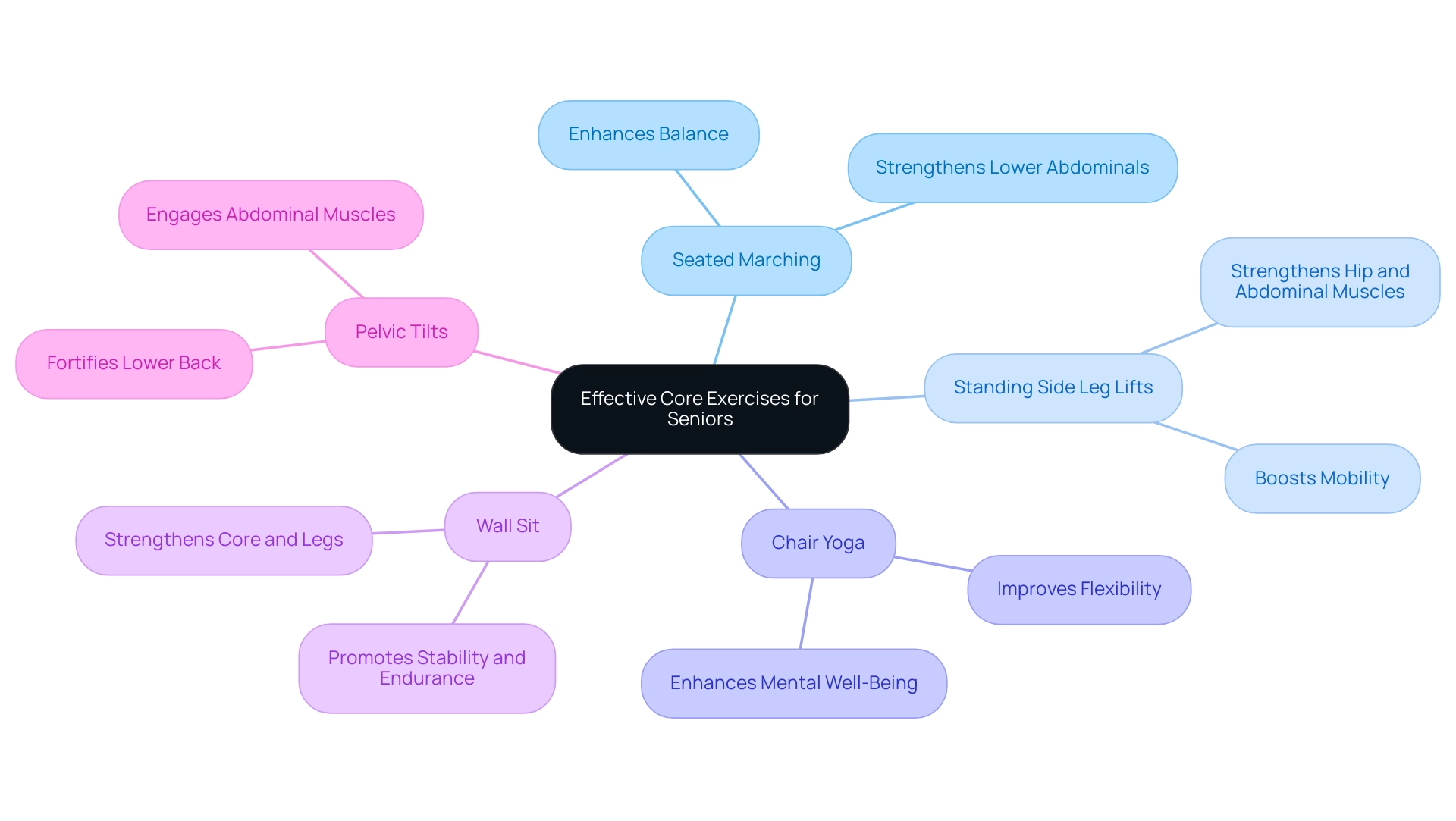
Benefits of Core Exercises: Balance, Posture, and Injury Prevention
Engaging in core exercises seniors provides a multitude of benefits, making it an essential part of their health and well-being. Here are some key benefits:
-
Improved Balance: Incorporating core exercises seniors into their routine significantly enhances stability, which is crucial in reducing the risk of falls and injuries.
Recent research indicates that fundamental stability training can lead to substantial improvements in jumping performance, with a standardized mean difference (SMD) of 0.86, underscoring its role in balance.
-
Better Posture: Core exercises seniors should incorporate are essential for supporting the spine, fostering better alignment, and alleviating discomfort often associated with poor posture. This is particularly important for older adults, as good posture can prevent a variety of musculoskeletal issues.
-
Injury Prevention: Injury prevention through core exercises seniors is essential as strengthening central muscles plays a critical role in protecting the back and joints, minimizing the risk of injuries during daily activities. As Kwon-Young Kang, PhD, PT, notes,
Core muscle stability training should be considered as a therapeutic method for the elderly to improve their WDI and SI, and as a fall prevention measure.
This viewpoint highlights the efficacy of focused fundamental workouts in injury prevention.Moreover, insights from personal interviews show that numerous seniors encounter a significant reduction in injury occurrences after integrating fundamental workouts into their routines.
-
Enhanced Mobility: Core exercises for seniors improve central strength, contributing to greater ease of movement, which makes everyday tasks less challenging and promotes independence. This increase in mobility can lead to a more active lifestyle, which is essential for overall health.
-
Increased Confidence: As seniors gain strength and stability, they often experience a boost in confidence regarding their ability to navigate their environment. This newfound confidence can motivate them to participate more fully in social activities and daily routines.
Additionally, a recent meta-analysis on core training effects indicates that core exercises for seniors show small to large effects on performance variables, with significant improvements noted in balance and jumping, which further supports the importance of core workouts for seniors.
By prioritizing core health, HR Benefits Managers can play a pivotal role in enhancing the well-being of seniors, ultimately leading to healthier, more active lifestyles.
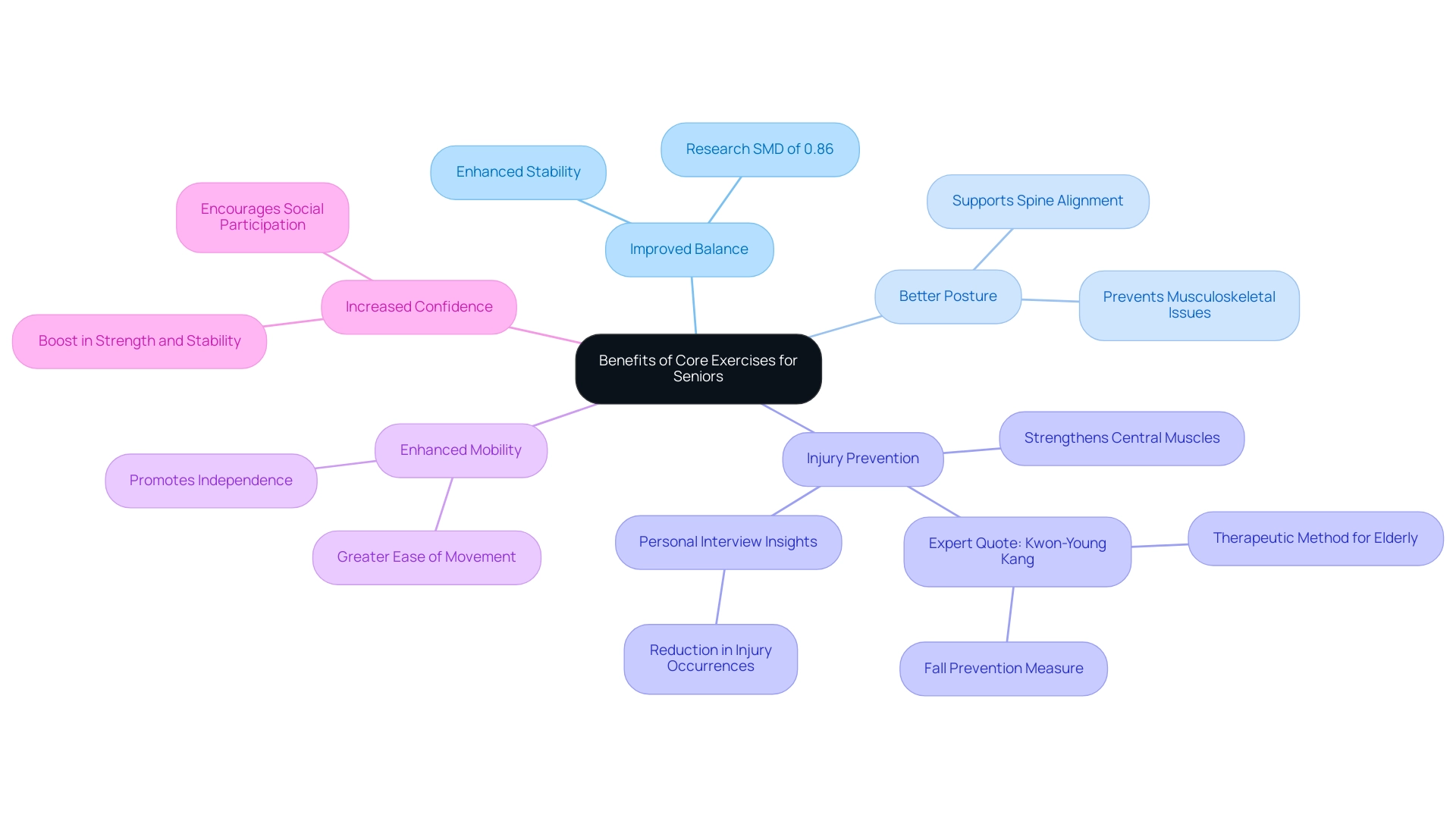
Safety Tips and Modifications for Core Exercises
-
Start Slow: Initiating a fitness journey should begin with a few repetitions, slowly increasing as strength develops. This gradual approach is crucial, as statistics show that the incidence rate of exercise-related injuries in older adults stands at 14%. To mitigate these risks, it's essential to prioritize safety and comfort. Personal trainers recommend starting fitness regimens gradually, such as walking before jogging and lifting lighter weights before progressing to heavier ones.
-
Use Support: Incorporating support, such as chairs or walls, can significantly enhance balance during standing activities, reducing the risk of falls. This strategy not only fosters confidence but also encourages consistent participation in fitness activities. Safety tips from fitness experts recommend using sturdy furniture for support and ensuring that the activity area is free of hazards.
Listen to Your Body: Always pay attention to any discomfort or pain felt during physical activity. It's vital to modify or halt the activity if necessary, ensuring that personal well-being remains the top priority. Brock emphasizes this approach, stating,
It’s critical to read, ask questions, and approach anything new slowly and patiently.
This mindset can empower older adults to embrace fitness safely.
-
Consult a Healthcare Professional: Before starting any new fitness program, especially for individuals with existing health concerns, it is imperative to consult with healthcare providers, such as doctors or physical therapists. Their guidance can ensure a safe and effective start.
-
Focus on Form: Proper posture during workouts is essential to prevent strain and injuries. It's preferable to perform fewer repetitions with correct form than to rush through them incorrectly. By emphasizing quality over quantity, seniors can achieve better results in core exercises and enhance their overall fitness experience.
Case Study Insight: Organizations like Age Safe America® focus on enhancing safety and independence for seniors through Home Safety Assessments and Aging-in-Place Home Modifications. Their method involves offering evaluations, solutions, and product suggestions that can assist seniors in safely engaging in core exercises they need to stay active at home.
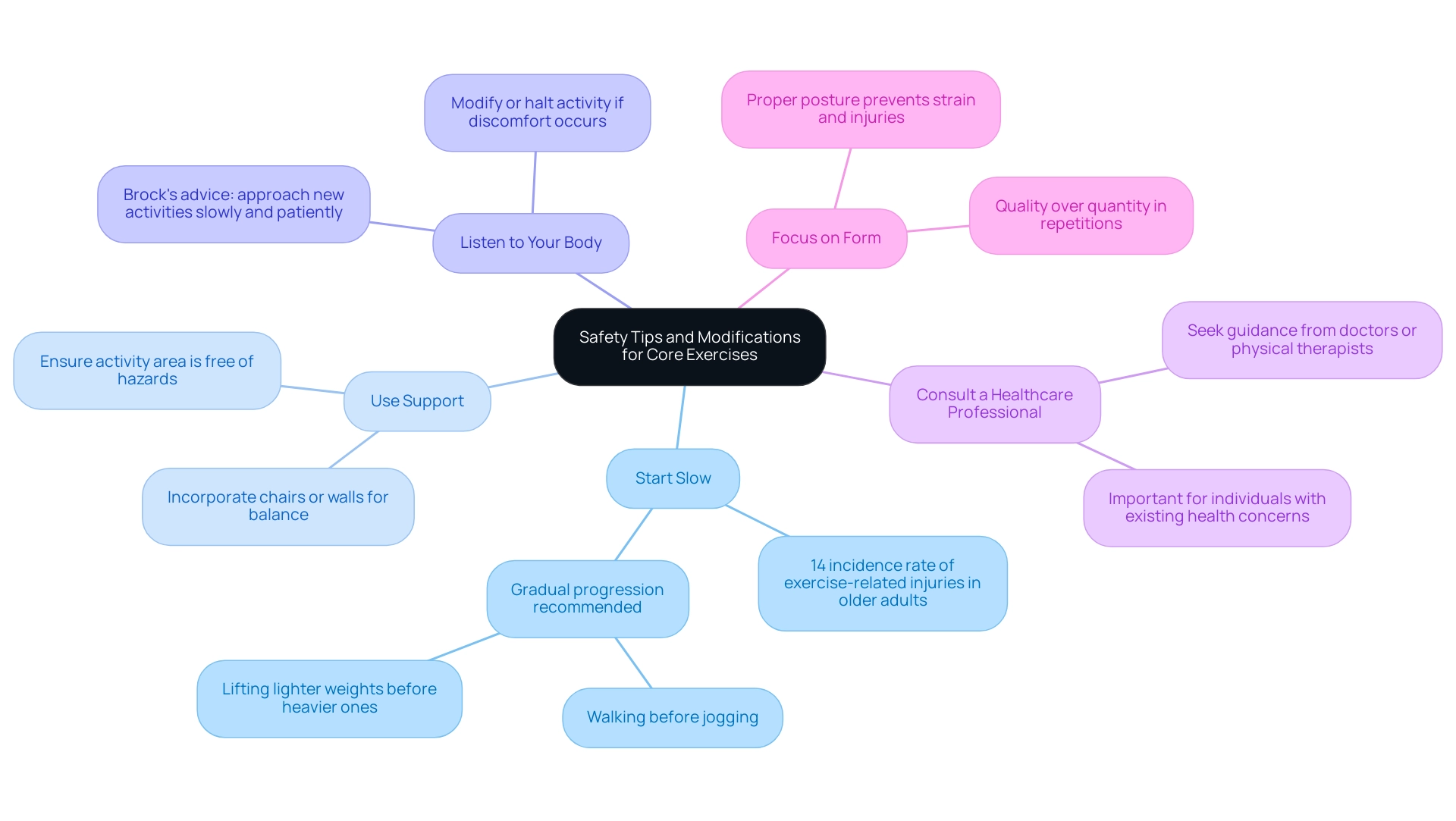
Incorporating Core Exercises into Daily Life
- Morning Routine: Kickstart the day with core exercises seniors can perform right from bed or shortly after waking. Simple movements like seated marching or pelvic tilts not only ease you into the day but also set a positive tone for maintaining physical health. Participating in these activities enhances the overall wellness of seniors, particularly as research indicates a notable rise in physical activity involvement over the years. According to the NHIS, the proportion of older adults engaging in no leisure-time physical activity decreased from 55.9% in 1998 to 43.0% in 2013, highlighting a positive trend in senior fitness.
- Incorporate into TV Time: Turn your favorite television shows into opportunities for physical activity! While enjoying a program, consider doing seated activities. Movements such as seated leg lifts or arm raises can seamlessly blend into your viewing experience, ensuring that staying active feels effortless and enjoyable.
- Use Household Items: Get creative with everyday items around the house. For instance, use the kitchen counter for support while performing leg lifts or balance exercises. This approach not only utilizes familiar surroundings but also encourages physical activity without requiring specific equipment—making fitness accessible and practical.
- Join a Class: Seek out community classes, whether in-person or online, tailored specifically for seniors. Participating in group sessions not only promotes physical health but also fosters social interaction, which is vital for mental well-being. Classes tailored for seniors can motivate and inspire, creating a supportive environment for enhancing fitness levels. The BRFSS trends indicate that the proportion of adults reporting no leisure-time physical activity decreased from 40.4% to 33.9% between 1994 and 2013, suggesting that such classes can effectively contribute to meeting physical activity guidelines.
- Set Reminders: Establish a routine by setting phone alarms or placing sticky notes in visible areas to remind oneself to participate in core activities throughout the day. This simple tactic can transform core exercises for seniors from an afterthought into a regular part of daily life. Dr. Sarah Kozey Keadle emphasizes, "Although older adults are reporting more activity over time, adherence to aerobic and strength training PAG remains low in this population, and there is a need for effective interventions to prevent age-related declines in PA and address health disparities among older adults." Creating reminders is a practical step toward achieving that goal.
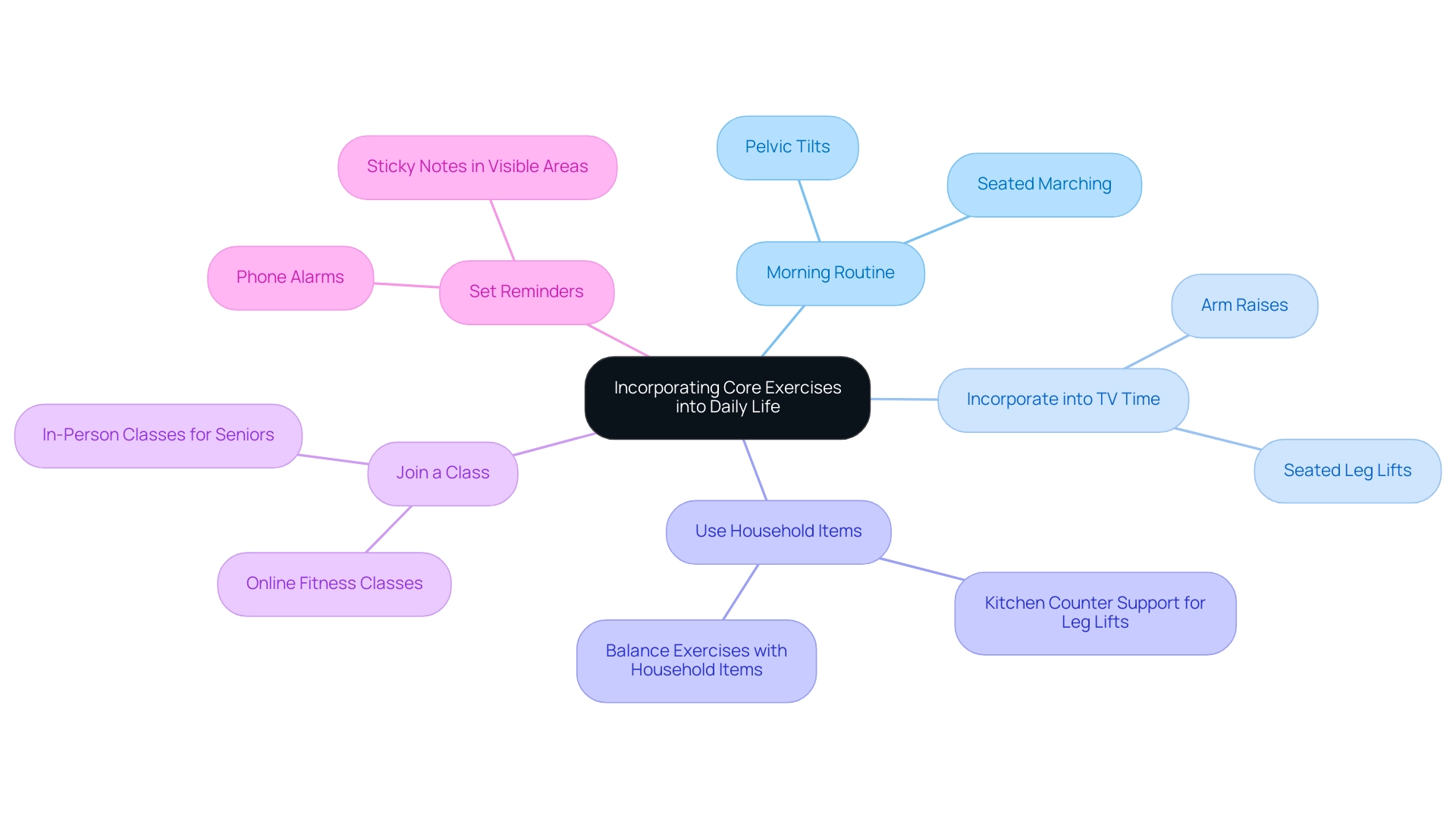
Conclusion
Core strength is undeniably a cornerstone of health and well-being for seniors, playing a pivotal role in enhancing stability, balance, and overall mobility. By engaging in targeted core exercises, older adults can combat the natural decline in muscle mass and strength that accompanies aging, ultimately leading to improved quality of life. The evidence presented highlights the profound impact that core strength has on reducing fall risk, enhancing posture, and fostering greater independence.
The benefits of incorporating core exercises into daily routines cannot be overstated. From simple movements like:
- Seated marching
- Pelvic tilts
to more dynamic exercises such as:
- Wall sits
- Chair yoga
there are numerous ways for seniors to strengthen their core while enjoying the process. These exercises not only contribute to physical health but also instill a sense of confidence that encourages participation in social activities and a more active lifestyle.
As HR Benefits Managers aim to empower older adults, prioritizing core strength within wellness programs emerges as a critical strategy. By promoting safe, effective exercise routines and fostering an environment that encourages physical activity, organizations can significantly enhance the lives of seniors. Embracing core health is not just about preventing falls; it’s about cultivating a vibrant, active, and fulfilling life for older adults, ensuring they navigate their daily activities with confidence and ease. Now is the time to take action and make core strength a fundamental aspect of health and wellness initiatives for seniors.




